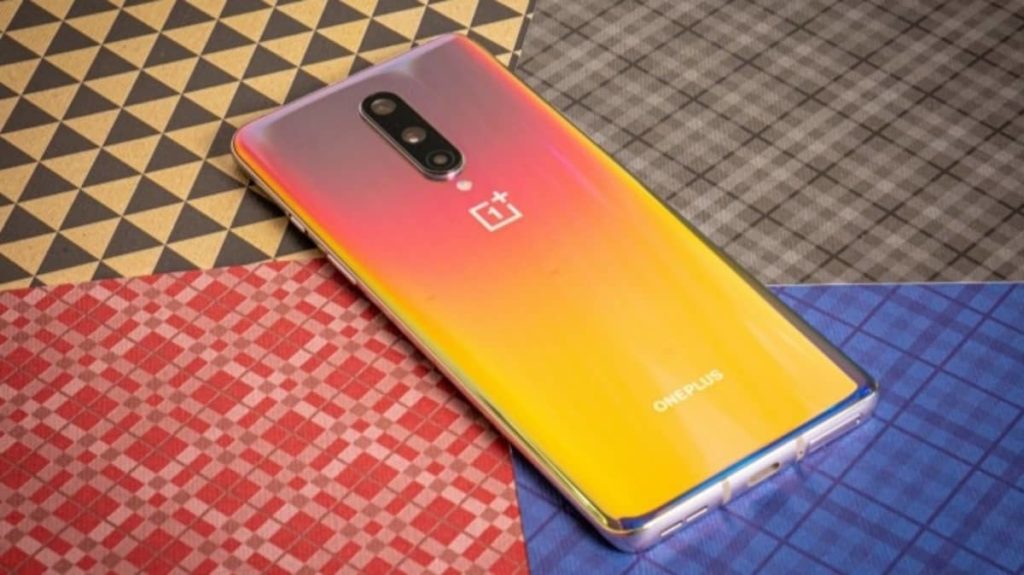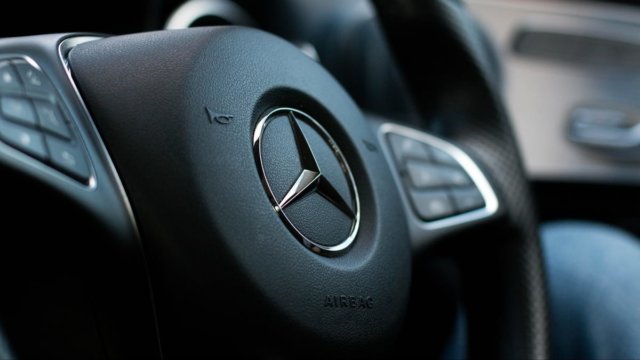Overview
OnePlus 8 is basically built with the purpose of beating the iPhone 11. Everything from the cameras, to the pricing, to the colour choice, makes it pretty clear what OnePlus have their sights set on. So let’s find out if it does that.
Before we proceed, I will like to say that I love the retail packaging on this new OnePlus phones. If OnePlus are going to raise the prices of their phones from mid-range to almost high-end, it’s good to see that they’re presented accordingly.
Key Features of OnePlus 8:
- OnePlus 8 has two more CPU cores than the iPhone 11, resulting in better parallelism. Which means, in theory, more tasks can be processed in parallel without slowing down the User Interface.
- 100% more RAM than Apple iPhone 11 ( 8GB vs 4GB). More RAM means more applications can run at the same time, which further implies that more applications can be kept open in background processes without having to restart the application.
- 7% larger screen than Apple iPhone 11 (6.55inch versus 6.1inch). Reading, browsing internet and watching movies is more pleasing experience on a bigger screen.
- Better Screen Resolution (1080 x 2400 pixels versus 828 x 1792 pixels). 74% more pixels than the iPhone 11. More resolution means sharper and crisper screen.
- Better Camera Resolution (48 MP vs 12 MP). Around 300% more mega pixels (MP) than iPhone 11. More resolution generally means more picture details, this doesn’t always hold true though.
- More Camera Flexibility. With the triple camera setup on OnePlus 8 versus Apple’s iPhone 11 dual camera setup.
- A comparison between both phones’ base model gives you around 100% more internal storage on OnePlus 8 (128 GB) than iPhone 11 (64GB).
- OnePlus 8 offers 4,300mAh, which is around 38% more Battery Capacity than Apple’s iPhone 11 (3,110mAh). With more battery size, device’s battery can theoretically last longer. But due to Apple’s A13 Bionic Chip power consumption efficiency, both phones have a somewhat similar battery performance.
- Faster charging speed with 30W charger, which gives you 50% in 22 minutes.
- Fingerprint sensor support allows you to quickly unlock your device using your fingerprint.
Key Features of iPhone 11:
- It has a front camera flash, which can be very useful at low lighting conditions.
- A better security with the 3D face scanner. Apple’s Face ID supposedly offers better security than any on-screen fingerprint sensor currently in the market.
- The iPhone 11 animations feels smoother on the eye.
- Slightly faster processing power (roughly 1% faster).
- Better photo quality. This is a rather relative difference. However, the iPhone still remains the undisputed King of Portrait Shots. Only Google’s Pixel can give the iPhone a tougher time.
Design
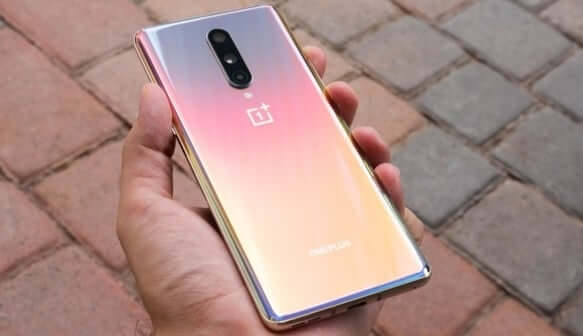
The OnePlus 8 is pretty much the most comfortable phone I’ve ever held. The phone has the same curved back and soft touch matte finish as it’s pro counterpart but it’s slimmer, has a smaller camera and is notably lighter.
That, my friends, is quite a combination. It feels better than my Samsung to hold, better than my Huawei. And it feels sure enough better than the iPhone 11.
However, the iPhone 11 is hardly a bad feeling phone. I like the matte rails all the way around the sides, and it’s palm friendly size. It’s almost completely usable with one hand, which brings me to the only thing I would say about the OnePlus 8 design.
It may be the slimmer and lighter phone from the company, but it’s still not small enough. The display is tall enough that I can still barely reach halfway up with my thumb, but that display, holy moly, the difference is just astronomical by every possible metric I could think of.
The OnePlus 8 is 160.2 mm tall, 72.9 mm wide and 8 mm thick. As for the iPhone 11, it has a 150.9 x 75.7 x 8.3 mm dimension. The iPhone 11 being the shorter phone, makes it easier to reach the top of its display with my thumb. Although I still have to do some thimb gymnastics.
The colour options available on the OnePlus 8 is Onyx Black, Glacial Green, Interstellar Glow and Polar Silver. While the iPhone 11 has a Black, Green, Yellow, Purple, Red and White colour option.
Display
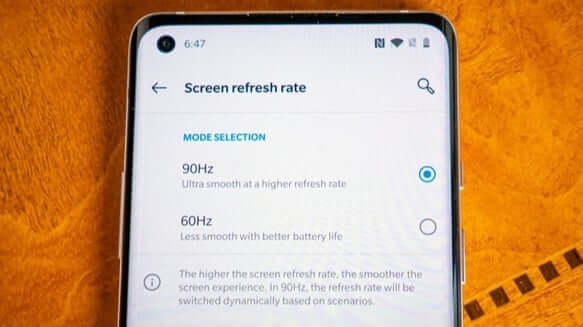
OnePlus 8 has the better panel, it’s larger 6.55 inches versus 6.1 of the iPhone 11. The OnePlus 8 uses Fluid AMOLED tech for deeper contrast than Apple’s LCD and it’s much higher resolution.
You’re looking at a full HD+ panel (1080 x 2400), which gives it about 80% more pixels on its screen than the iPhone 11 with a 828 x 1792 LCD panel. But the gap gets bigger, you’ve got OnePlus’s slim border and tiny hole punch cut out, which makes the iPhone 11 look a little bit like a toy in comparison.
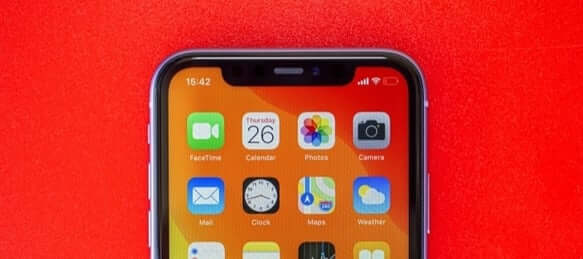
The iPhone 11 is a little brighter if you’re looking head on. Even so, because of how LCD screen quality tends to deteriorate from harsh viewing angles, One Plus 8 is much brighter when you’re looking from anywhere but head on. I really can’t emphasize this enough, from the front these phones quite literally look five years apart.
The OnePlus 8 looks like the high-end Ferrari’s 2020 F8 Tributo, while the iPhone 11 is Ferrari’s 2015 458 Italia. Credits to the ugly notch on the iPhone.
Then add to that, the OnePlus 8 has a fluid 90 Hertz refresh rate versus iPhone 11’s 60, so it’s more responsive too. It’s not 120 Hz like the OnePlus 8 Pro, but I think there is a bigger jump between 60Hz and 90Hz than there is between 90Hz and 120Hz.
Anyways, even though Apple’s iPhone 11 display doesn’t exactly fill you with confidence, you can’t say this is not a seriously fast phone.
Security
Well, with the iPhone 11 you’ll be using secure 3D face unlock, which to be fair is probably the more seamless option between the two. OnePlus does face scanning too but because it’s just using a front camera not a proper 3D scanner, it could potentially in theory be breached by someone if they really want to get into your phone.
Hence, in the screen of the OnePlus you’ve got a fingerprint scanner with a scanning area wide enough that you can even miss it slightly and you’ll still get in.
Camera
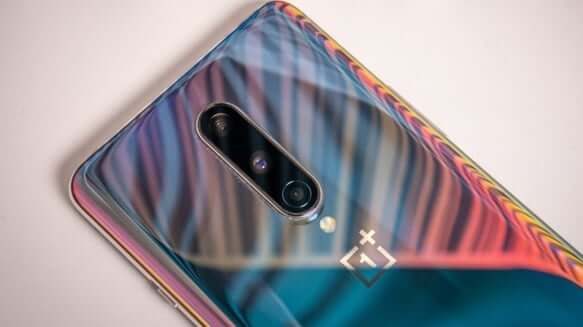
The OnePlus 8 has three rear cameras, consisting of a 48MP main, 16MP ultra-wide and 2MP macro lens. Also, it has a 16MP front facing camera. The iPhone 11’s specs are easiest to remember, as it has a 12MP main and 12MP ultra-wide camera on the back, together with an extra 12MP selfie camera at the front.
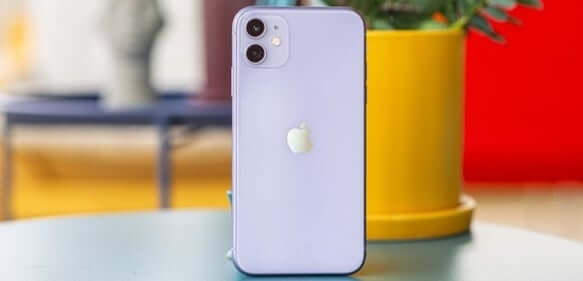
Unfortunately, though, the 48MP sensor used for the OnePlus 8 isn’t the same as on the 8 Pro. It uses an older generation of Sony IMX586 image sensor with the 0.8µm pixels instead of the big 1.12µm pixels, Sony IMX689, used in 8 Pro. You still get OIS and big f/1.75 aperture though.
So both phones have one main camera and one ultra wide. And then OnePlus also has a third macro camera, which to be honest is a bit strange. I’ve got nothing against macro cameras, but in my eyes there’s a clear hierarchy of importance in smartphone’s camera systems.
Where does a Macro Camera fall in the Hierarchy of Importance?
You’ve got a high end main camera, you need that. Then, you want an ultra wide, and then if you’ve got resources let’s have a telephoto.
Then if you still got resources at your disposal, we’ll have a macro camera. But in terms of priority it’s like, you know somewhere down the bottom of the hierarchy. Yeah, telephoto would have been better, but I guess a macro camera is just cheaper.
Anyways, I mentioned earlier that OnePlus is clearly targeting the iPhone 11 with this phone. And it’s kind of obvious. I mean, everyone wants a piece of Apple’s market share, but another tell-tale sign is specifically what they’ve done with the cameras.
Both phones have made the decision to have an ultra wide, escape the telephoto camera, which at this kind of upper mid-range/ high-end price is actually quite a rare move.
My Thoughts on the Camera Specs
Maybe the company is still trying to keep three cameras on the phone, so it doesn’t look like a downgrade from last year’s 7T. As it stands, this macro camera, even in ideal lighting conditions is just not very good and has some strange circular lens blur.
But as far as the two main lenses on the OnePlus 8, I’m pretty impressed. I was kind of raising my eyebrows during my briefing of the phone because you’ve got the same camera hardware as last year’s OnePlus 7T and very similar to the OnePlus 7 before that.
And to be very clear, I don’t like that idea. I would honestly expect, given this is a new generation phones supposedly, from a company as ambitious as OnePlus, that we’d be getting new generation camera hardware.
But I tried to go in removing those preconceptions and I actually came away quite impressed. The company is making big strides in software processing. For the most part, I think OnePlus’s daytime photos look crispier than Apple’s and I prefer the slightly extra punch it adds to scenes.
The Good News
While neither has a telephoto camera, OnePlus’s higher resolution main camera means that zoom photos do look better. They’ve also improved video on the 8, but Apple is still king controlling more dynamic range.
OnePlus sort of crushes the shadows a little bit. Also, like with the Pro variant, if you’re trying to focus on fine objects, OnePlus seems to just keep slipping in and out of focus. While the iPhone is bang on consistently.
Apart from these camera nickels though, a lot of this comparison is just a case of OnePlus doing things better than Apple, even a lot of other things they’ve been lacking on past OnePlus phones. They’ve kind of been brought up to par here.
Specs
In terms of performance, it’s every bit as well-spec as a thousand dollar iPhone 11 Pro. It’s sings along no matter the task, whatever game, whatever app, you’ll struggle to make the phone skip a beat. Mind you, the same thing is true for OnePlus 8. It’s using the latest Snapdragon 865 chip, ultra fast UFS 3.2 storage, and up to 12GB of RAM, with 8GB of RAM at base level.
The iPhone 11 offers up to 256GB of internal storage or 64GB at base level. All variants comes with a 4GB of RAM and an A13 Bionic chipset, which seems to be the most top-end chipset available to smartphones right now. Just a little ahead of OnePlus Snapdragon 865 chip.
The only thing it loses versus the OnePlus 8 Pro (its elder brother) is that it has slightly alter LPDDR4 X RAM versus LPDDR5, which consumes forty-five percent more power and fifty percent slower.
Speed Test
Between these two, the OnePlus 8 and the iPhone 11, AnTuTu benchmark will tell you the iPhone 11 has a 1.5 times faster single-core performance. And 1.03 times faster than the OnePlus 8 in multiple-core test, if you want to put a number on it.
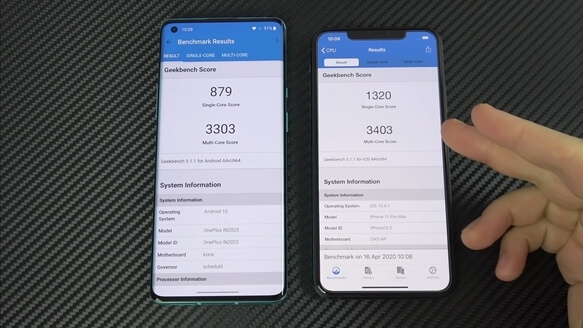
However, I personally struggled to see a difference. What I did notice though with the OnePlus 8, with its slightly more up-to-date spec sheet, is a couple of more general performance improvements.
A better Wi-Fi range, for example, I could sit in my back garden watching videos on the OnePlus 8 and 5G enabled. For a lot of people, this isn’t exactly a big deal right now, but in two years time when you’re still using the same phone it might well be.
Connectivity
You might want to be able to pop a 5G SIM card in. It’s tricky but because I think given the choice OnePlus wouldn’t have added 5G to this non-pro OnePlus 8 because it’s expensive. It’s a big part of the reason why this phone costs what it does.
The problem is that, it’s not enough competition in the smartphone chip market If you want the best performance you need to use Qualcomm Snapdragon 865 chip. But then with that Qualcomm bundles a mandatory 5G modem, as a result this phone is probably at least $50 more expensive than OnePlus would have wanted it to be.
Haptics
Typing and interacting with your iPhone 11 gives you lovely crispy vibration feedback. The OnePlus 8 isn’t very much different in this regard.
Sound
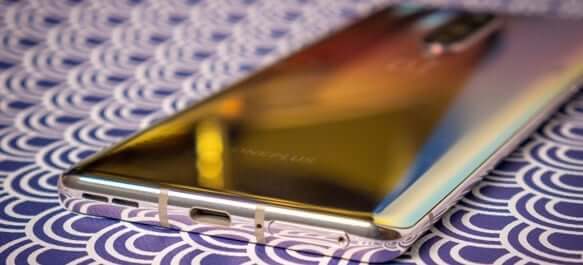
The OnePlus 8 has a Dolby Atmos dual speaker set up, one on the front and one on the bottom. It’s very similar to the one of the iPhone’s, but what I would give to OnePlus 8 is that the vocals are even crisper.
Battery
While OnePlus ships with a powerful 30-Watts fast charger. The iPhone ships weith the 5-watt charger that would have made 2011 proud. And it takes like three hours to fully charge. And one plus is battery capacity is also larger with 4,300mAh versus Apple’s 3,110mAh battery. But iPhone 11 tend to be more efficient with the battery they do have.
So we’ll find out on a detailed battery comparison very soon.
Drawbacks
The two main OnePlus omissions here are a lack of wireless charging and a lack of an official IP certification for water and dust resistance. Both of which the iPhone 11 has. These might be big issues for you. For me, personally, they’re small, especially against the backdrop of the batteries situation.
Verdict
One that note then, the only real case to be made for the iPhone 11 over the OnePlus 8 is software. Android versus iOS situation. So if things like FaceTime and AirDrop and being able to make phone calls on your Mac are really important to you, then you should think carefully about moving to Android because you’ll lose them.
But for every other user, android users, Apple users who aren’t to invested, and those poor souls still on a Blackberry phone. The OnePlus 8 is victory. Right out of the box, almost everything is the way I would want to on my phone. It gets a lot of the big things right but also a lot of the small things.
With the OnePlus 8, you’ve got a sleek clean user interface, a swipe up anywhere on your screen turning up your app drawer, a swipe down feel quick toggles. Double tap to switch from back to front camera.
Simple things and also hardware-wise, that fingerprint resistant matte finish, 128 gigabytes of storage on the base model and the fact that the phone comes pre-fitted with a screen protector.
These are all great user-friendly decisions.
Zerofy Editorial is a team of writers determined to provide evergreen content to millions of readers worldwide.
